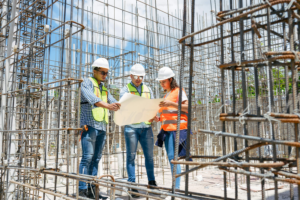Plumbing is a demanding career. Whether they’re fixing a clogged drain or laying out piping for a new kitchen, plumbers must have physical stamina and a high tolerance for messy work.

Service plumbers regularly interact with clients and must be able to explain complex issues clearly, provide accurate cost estimates, and follow safety protocols. They may also need to perform inspections on plumbing systems and equipment. Contact Plumber Provo for professional help.
Plumbers install piping and fixtures in homes and businesses. Their work includes connecting water lines to appliances like sinks, toilets, and showers; installing gas line systems for stoves and ovens; and ensuring that all plumbing components comply with local codes and standards. They also repair existing pipes and fixtures, including those that are leaking, broken, or damaged. Some plumbers specialize in residential or commercial plumbing, while others focus on industrial plumbing or irrigation systems.
To become a plumber, you typically need at least a high school diploma or equivalent and extensive training as an apprentice under a master plumber. Many plumbing apprenticeship programs are offered through unions and trade organizations. The apprenticeship process can take between three and five years. After completing the program, you must pass a state exam to earn your journeyman plumber certification. Some plumbers also choose to pursue additional certifications, such as those focusing on energy efficiency or green plumbing practices.
Before starting a plumbing project, plumbers must read blueprints and carefully plan the piping system’s layout. They may use specialized tools to measure and mark the location of pipe joints. During the installation process, they may have to remove existing drywall or flooring to access the piping beneath. After the piping is installed, plumbers test it for leaks and ensure that all connections are secure.
Plumbers are also responsible for removing and disposing of waste, including human waste. To protect themselves from infectious diseases, they wear protective gloves and masks when handling sewage waste. In addition, they must regularly clean their work area and tools to avoid exposure to bacteria and other contaminants. Plumbers who install septic tanks and sewer lines must also be aware of the health risks involved in these projects.
Plumbing systems provide essential services for households and businesses. They carry water, waste, and sewage to and from fixtures and appliances, and they regulate indoor climate through pipes, valves, and fixtures. The pipes in a plumbing system must be durable and reliable, and they must be able to withstand pressure and temperature fluctuations. Plumbers use a variety of tools and machines to inspect, maintain, and repair these systems. They must also be able to work safely in tight spaces and around dangerous machinery.
Maintenance
A plumber’s job duties are not limited to installation, as they often have to repair and maintain existing water systems. This involves finding and fixing issues like leaking pipes, toilets that don’t flush and clogged drains. It also includes installing new plumbing fixtures, such as sinks, faucets, shower heads and bath tubs. Plumbers must be able to read blueprints and understand building codes to install these components properly.
Some plumbers specialize in certain aspects of plumbing, such as kitchen and bathroom remodeling. These professionals can design these spaces to be both functional and aesthetically pleasing. They may also offer advice on energy-efficient plumbing solutions. Other plumbers focus on pipe relining and trenchless technology, which allows them to repair or replace pipes without having to dig up the entire yard. This can be beneficial for homeowners who are concerned about the disruption to their landscaping.
Plumbers may work on both residential and commercial properties. They can be self-employed contractors or employees of large companies that contract their services out to homeowners. They must be comfortable working in a wide range of environments, from crawl spaces to attics to basements and outdoor areas. Plumbers are typically required to wear protective clothing and use specialized tools to perform their tasks.
In addition to repairing and maintaining plumbing systems, plumbers are sometimes called upon to diagnose problems. This can involve using specialized equipment such as video cameras and pressure gauges to inspect pipes for damage or leaks. They must be able to identify the source of the problem and recommend the most effective solution.
Regular plumbing maintenance can help reduce costly repairs and improve the longevity of plumbing fixtures. It can also help homeowners save money on energy bills and keep their homes safe and healthy. Plumbers who are skilled at performing routine inspections and maintenance can find small issues before they become bigger, more expensive problems. Those who are interested in becoming plumbers should consider taking post-secondary education and apprenticeship programs to gain the necessary skills and knowledge. They should also be willing to learn about new technologies and methods to stay current in the industry.
Troubleshooting
Problems with plumbing are bound to arise at some point, and when they do, it’s important for home owners to know when to call a plumber. This way, they can avoid escalating issues like plumbing leaks, clogged drains, and water heater failure. In some cases, these issues may even require emergency services. But for most, a little proactive maintenance and troubleshooting can go a long way in keeping your home’s plumbing functioning properly.
One of the most common plumbing problems is leaking pipes. Leaky pipes can lead to significant water damage in your home, resulting in expensive repairs and high utility bills. If left unattended, a plumbing leak can also cause mold and mildew to grow inside your home. To prevent leaks from happening, be sure to check the condition of your pipes on a regular basis and replace them if they’re damaged or worn out.
Another common plumbing problem is clogged toilets. These can be caused by a variety of factors, including overuse of your toilet’s flushing capabilities and the improper disposal of solid waste. Flushing items like baby wipes, hygiene products, and excessive amounts of toilet paper can lead to blockages in your home’s plumbing lines. In some cases, your plumber may need to use specialized tools to remove the clog and repair the sewer line.
A plumber’s job can also involve troubleshooting and repairing other home appliances, such as your washing machine or refrigerator. If your washer or fridge isn’t working as it should, the plumber can help diagnose the issue and recommend a solution. Likewise, if your dishwasher isn’t draining properly, the plumber can inspect the machine and repair or replace it as necessary.
It’s also important for homeowners to understand the basic principles of troubleshooting so they can be more prepared to handle simple plumbing problems on their own, such as replacing a washer or repairing a leaking faucet. Additionally, by using a plumbing CMMS such as MaintainX, they can quickly identify and resolve recurring issues, ensuring their home’s plumbing system stays in tip-top shape.
Inspection
Plumbing inspections are an important part of keeping your home’s plumbing healthy and safe. They help you catch issues like leaks and clogs before they become major problems that require costly repairs or replacements. A plumber will use a variety of tools and techniques to examine your plumbing system, including visual inspections, specialized camera inspections, water quality testing, and more. They will also check that your shut-off valves are working properly and ensure that your pipes are made of durable, long-lasting materials.
The inspection process can be lengthy and involved, depending on the scope of your plumbing needs. If you have a lot of fixtures and appliances, for example, your plumber may need to inspect each one individually. The best way to prepare for a plumbing inspection is to make sure that the plumber has full access to your sinks, toilets, tubs, and other fixtures. You should clear out the areas around them and remove any clutter or debris. This can help the inspection go more quickly and smoothly. You should also familiarize yourself with your plumbing systems and note any areas that you’ve noticed trouble with, like slow-draining sinks or a water heater that isn’t producing hot water.
Your plumber will provide a comprehensive report on their findings, which should include details about the condition of each fixture and pipe. They will also recommend any necessary maintenance or repair work. They will distinguish between urgent needs and recommendations for future maintenance, and they’ll explain the costs of each solution. They’ll also offer suggestions for upgrading your plumbing equipment, such as new low-flow fixtures that can save you money on your water bill.
Plumbing inspections are also a great time to talk to your plumber about any concerns or questions you have about your plumbing. They can help you create a maintenance plan that will keep your plumbing in good condition and prevent issues down the road. Plus, if you’re interested in saving money on your energy bills, your plumber can show you the latest water-saving fixtures and appliances that can cut your bills significantly.


